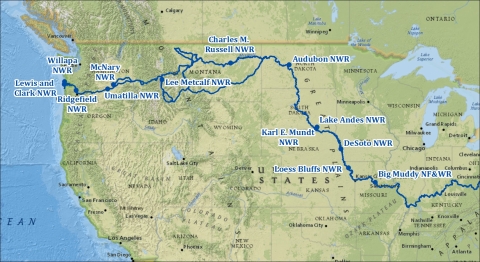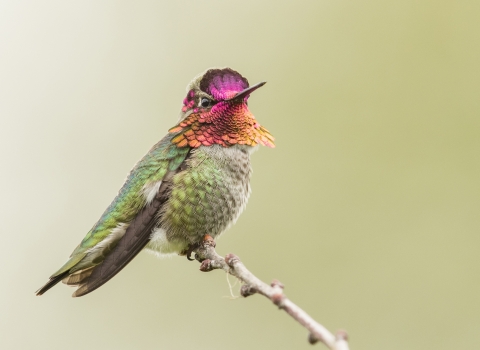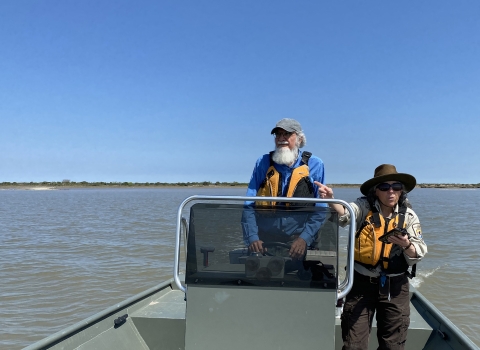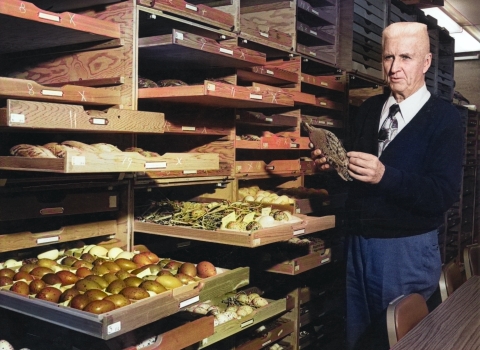The vast stretches of the Great Plains are home to some of the most renowned pieces of our country’s history; from Lewis and Clark’s famous expedition to the birthplace of the Homestead Act, these grasslands are a treasured part of American heritage. Conserving this great landscape is not only important for the communities and species who call it home, but also for the preservation of our nation’s rich history.
Originally part of the Louisiana Purchase of 1803, the Great Plains have since become the stage for many of our nation’s landmark moments. When Lewis and Clark made their famous westward journey, they crossed through the prairies of Kansas, Nebraska, Iowa, South Dakota, North Dakota, and Montana. Following their footsteps, hundreds of thousands of American settlers followed them west, forming what we now know as the Oregon Trail, which connected the Missouri River to Oregon—and became immortalized in popular culture with the game The Oregon Trail, which features key landmarks across the Great Plains.
The Foundations of a Nation
As the country grew and expanded, the Great Plains played a critical role in many formative moments throughout American history, including the American Indian Wars, the Battle of San Jacinto—securing Texas independence from Mexico—and the American Civil War. Near the end of the 19th Century, the region became highly sought-after with the establishment of the Homestead Act of 1862, drawing settlers into the region, and the expansion of the Gold Rush into Montana in 1862 and South Dakota in 1874.
Considered by many to be an American conservation hero, President Theodore Roosevelt is an especially prominent figure in the American prairies, and it can be argued that Roosevelt’s passion for conservation was born in the grasslands of North Dakota. It was after he purchased and began managing rangeland in North Dakota when President Roosevelt became a conservation activist, starting with efforts to address overgrazing. President Roosevelt’s conservation career continued to evolve, and during his presidency, he protected approximately 230 million acres of public land, establishing 150 National Forests, 4 game preserves, and 51 bird reserves, including what would become the first unit of the National Wildlife Refuge System on Pelican Island, Florida.
Crossing into the 20th Century, the Dust Bowl of the 1930s brought national attention to the Great Plains, the loss of agricultural production and plummeting land values together leading to food shortages and intensifying the economic hardships of the Great Depression. This attention was further magnified by the nation’s longstanding fascination with gunslingers of the American West, with notables like Wyatt Earp and Doc Holliday active in the plains of southeast Arizona in the 1800s—and whose shootout at the O.K. Corral was immortalized in the 1993 movie Tombstone starring the late Val Kilmer. In the Public Enemy Era of the 1930s, outlaws like Bonnie and Clyde drew the nation’s gaze back to the Wild West of the Great Plains with their infamous crime spree through Texas and Oklahoma.
Two decades later, the region extended its significance in the fight for civil rights, gleaning national attention in 1954 with Brown v. Board of Education of Topeka—a ruling that became a watershed moment for the American Civil Rights Movement.
Conserving a Legacy
Featured in award-winning movies like Dances with Wolves and beloved blockbusters like Twister, and home to Laura Ingalls from Little House on the Prairie, Dorothy Gale from The Wizard of Oz, and Laurey Williams from Oklahoma!, the Great Plains are a cornerstone of American heritage—but the cultural and economic value of these lands are not isolated to the past. Today, grasslands play a critical role in the American way of life, taking into account their importance to energy, recreation, tourism, and industry.
The grasslands of the Great Plains support many cultures, communities, and economies, as well as thousands of species—including migratory birds and mammals, waterfowl, and pollinators, and the ecological importance of grasslands extends beyond wildlife and species. Grasslands play a key role in ensuring clean, safe water for drinking, wildlife, agriculture, and industry by resupplying and filtering the water in aquifers and watersheds. Underground, the deep roots of grasses are critical for erosion regulation, drought and wildfire resilience, and soil health.
This landscape is not only vital for the species that call it home or use it as a migration corridor, but to the people and communities who live, work, and thrive in these areas. Grasslands and rural agrarian communities are the backbone of North America’s food supply, producing food and critical resources for the entire country and people around the world, in addition to providing millions of jobs. Hunting—particularly waterfowl hunting—fishing, birdwatching, hiking, and other outdoor activities are intrinsic to the culture of this region, and the revenue from recreation and tourism supports local communities and further conservation efforts.
The benefits and value of these grasslands are undeniable but, nevertheless, this ecosystem is being lost at a far faster pace than it is being conserved. Across the North American Great Plains, temperate grasslands are among the most imperiled and least conserved ecosystems on earth, once spanning more than 600 million acres across the United States, Canada, Mexico, and Indigenous Lands. Habitat loss from factors such as land conversion and invasive species invasive species
An invasive species is any plant or animal that has spread or been introduced into a new area where they are, or could, cause harm to the environment, economy, or human, animal, or plant health. Their unwelcome presence can destroy ecosystems and cost millions of dollars.
Learn more about invasive species have led to a loss of more than 62% of these grasslands.
Most of the land in the Great Plains is privately owned, shifting the bulk of conservation efforts to private landowners, many of whom are deeply invested in the preservation of this precious ecosystem—but they are not alone. Working alongside federal, state, and non-profit partners, landowners and communities are leveraging technical assistance and financial investments to achieve shared goals and conservation victories.
The Service and our partners rely on collaboration and continued funding to maintain and expand our conservation efforts. Together we are identifying common principles and collaborative priorities that address land conservation, partnerships, range and soil health, sustainable wildlife populations, economics, and sustainable human communities. Learn more about our efforts to conserve and restore this precious ecosystem.
If we are to save this precious ecosystem for the benefit of the American people—today and in the future—it will take a collaborative effort by federal, state, tribal, non-profit, and private partners. It is no small feat, but saving the Great Plains is part of the Administration’s commitment to ensuring a sustainable future that honors America’s heritage while fostering innovation, economic prosperity, and responsible resource management.


















